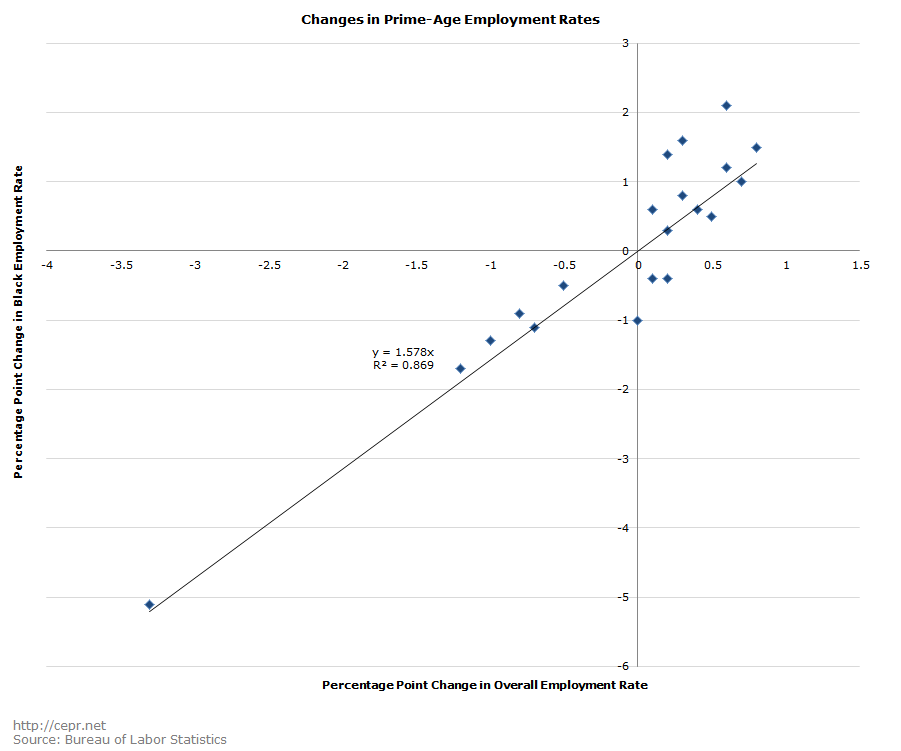September 14, 2015
A little over a month ago, while giving testimony before the U.S. House of Representatives, Federal Reserve (Fed) Chair Janet Yellen weighed in on whether or not monetary policy can be used to fight racial inequality in the economy:
“So, there really isn’t anything directly that the Federal Reserve can do to affect the structure of unemployment across groups, and unfortunately, it’s long been the case that African-American unemployment rates tend to be higher than those of on average among—in the nation as a whole. It reflects a number of different sources of disadvantage that are operative there.”
It’s true that many aspects of the racial divide in employment aren’t affected by monetary policy. The Fed can’t eradicate discriminatory hiring practices, racial inequality in the criminal justice system, or disparities in the quality of public schools. Nonetheless, it’s clear that the Fed can play at least some role in helping to create a more equal society.
The Federal Reserve has a dual mandate to pursue maximum employment and stable inflation. If the Fed were to raise interest rates—as some commentators are urging—it would have the effect of destroying jobs (and increasing the debt) for the sake of lowering inflation. This is despite the fact that inflation has been running below the Fed’s 2.0 percent annual target and is actually falling.
Weakening the labor market in this way would exacerbate racial inequality. If we look at rates of prime-age employment—which measures employment amongst Americans aged 25 to 54—we see that black Americans are disproportionately affected by changes in the labor market. This can be observed in the graph below, which compares changes in the overall prime-age employment rate (on the x-axis) with changes in the black prime-age employment rate (on the y-axis) from 1994 to 2014:

This indicates that for every 1 percentage point increase in overall prime-age employment, black prime-age employment is likely to increase about 1.6 percentage points. By contrast, for white Americans, the figure is only 0.9 percentage points. This means that for every 1 percentage point increase in overall prime-age employment, the racial prime-age employment gap falls about 0.7 percentage points.
It’s clear that completely eliminating the black-white prime-age employment gap requires powers beyond those granted to the Fed. In order to bring the gap to zero, the Fed would have to boost prime-age employment to about 88.0 percent for both groups—this is 6.5 percentage points above the highest all-time annual rate of 81.5 percent, which was achieved in 2000. However, even if the Fed can’t eliminate the gap, it can clearly reduce it. If the Fed were to hold interest rates near zero and allow the labor market to fully recover from the 2007–2009 recession,[1] it would likely cut the racial employment gap from 7.5 to 5.5 percentage points. If the prime-age employment rate were to rise as high as 81.7 percent, consistent with the prime-age employment rate from the late 1990s and early 2000s, these projections indicate that the racial gap would fall to 3.9 percentage points.[2]
The Fed shouldn’t be let off the hook when it comes to racial inequality. While the Fed’s policies are race-blind, it’s nonetheless true that a generally stronger labor market would disproportionately benefit black Americans. Black Americans were hurt the most of any racial group by the recession, so they have the most to gain from true recovery.
FedWatch is a semi-monthly online publication of the Center for Economic and Policy Research (CEPR) providing analysis by Dean Baker and colleagues of issues related to the pending Federal Reserve decision on interest rates.
[1]The year-round prime-age employment rate in 2014 was 76.7 percent, and it was 79.7 percent in the last quarter before the recession. This 3-percentage-point increase in overall prime-age employment correlates to a 2.0 percentage point decrease in the black-white gap in prime-age employment.
[2]For every quarter between the third quarter of 1997 and the first quarter of 2001, the prime-age employment rate was between 81 and 82 percent. The projections given here assume that the prime-age employment rate would rise from 76.7 percent—the rate for 2014—to 81.7 percent.






